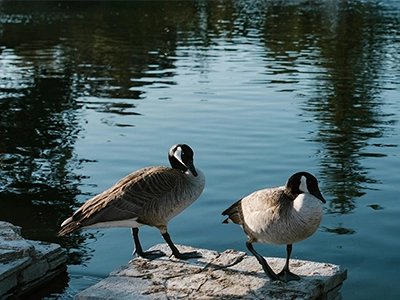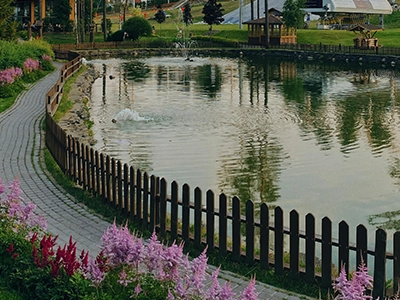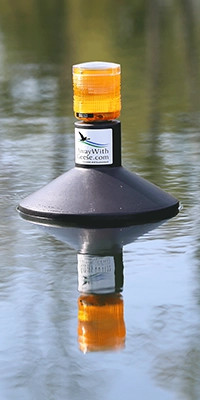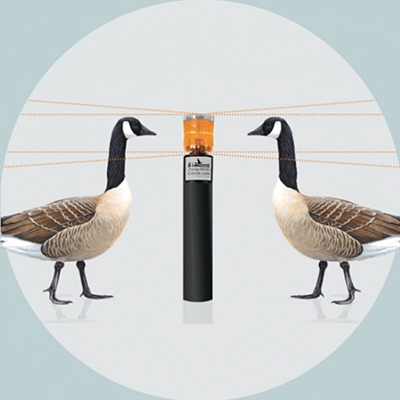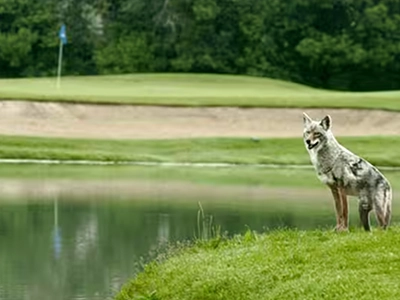7 Ways to Get Rid of Geese From Your Pond
We offer 7 Proven Ways to Get Rid of Geese in Your Pond
If your pond is overrun with Canadian geese turning your pond into their personal playground, you’re not alone. Canadian Geese have become increasingly problematic for pond owners across North Carolina, with non-migratory geese populations growing steadily over the past two decades. The good news? There are several effective, humane strategies you can use to reclaim you pond while staying within federal Canadian geese protection laws.
Table of Contents: What you will find in this post
• Introduction
• Why Geese are drawn to Ponds
• Are Geese Protected?
• Professional Dog Hazing Services
• Strategic Shoreline Barriers and Habitat Modification
• Audio Deterrent Systems and Noise-Making Devices
• Away with Geese Light Deterrents
• Decoy Deployment and Movement Strategies
• Remote-Controlled Harassment Tools
• Conclusion
• Frequently Asked Questions
Why Geese are drawn to ponds
Canada geese are naturally drawn to ponds for several reasons:
A) Open water provides safety for Geese from predators
B) Surrounding manicured lawns offer easy access and unlimited food sources
C) Quiet environments create an ideal home for feeding and nesting
Understanding these factors is key to implementing successful deterrent strategies. The more migrating Canadian geese you’re dealing with, the more intensive your Geese deterrents approach needs to be. Quite often you will need to use multiple geese deterrent devices working together for maximum effectiveness.
Are Canadian Geese Protected?
It’s crucial to understand that Canadian geese are federally protected under the Migratory Bird Treaty Act. This means you cannot harm the birds, their eggs, or nests without proper permits from the U.S. Fish and Wildlife Service. However, you can legally harass or scare them away as long as no physical harm occurs.
One of the long-term solutions involves hiring companies that use specially trained border collies or other herding dogs to chase geese away from your pond. These dogs are trained to harass geese without making physical contact, using their natural herding instincts to convince the birds that your property isn’t safe.
The beauty of this method lies in its consistency and natural approach. Dogs provide an unpredictable threat that geese take seriously. A single session can clear hundreds of geese within minutes, and with regular visits, the birds learn to avoid the area entirely.
For optimal results, professional dog hazing should be implemented 2-3 times per week during peak goose season (spring through fall). The frequency can be reduced once geese establish new roosting patterns elsewhere. This method works well for larger ponds or properties with significant goose populations, as one trained dog can cover extensive areas efficiently.
You might want to consider modifying your lawn maintenance practices around the pond. Allow grass to grow at least 6 inches tall, particularly during winter months, and reduce spring watering and fertilizing. Consider replacing Kentucky bluegrass with tall fescue, which geese don’t care for. These habitat modifications address the reason for geese being attracted to you pond.
Barriers should be installed as a permanent solution, shrubbery requires little to no maintenance once established. You want to create an environment that feels unsafe or inaccessible to geese while keeping your pond’s aesthetic appeal. This method becomes more critical as goose populations increase, as larger flocks require more extensive barriers to be effective.
Modern Canadian geese decoys and audio deterrent systems play recordings of goose alarm calls mixed with sounds of potential threats. These systems can clear large flocks within minutes, with some documented cases of 180 geese evacuating a pond in just five minutes. The combination of species-specific alarm calls with threatening sounds creates an immediate sense of danger.
Audio deterrents should be activated daily during peak activity times, typically dawn and dusk, for the first two weeks. After establishing the area as hostile, reduce frequency to every other day, then weekly as maintenance. Remember that geese can become accustomed to repetitive sounds, so vary your approach and timing for continued effectiveness.
This proven, effective solution scares geese away and keeps them away for good. To ensure complete coverage, place a unit every 100 yards and select the right type for your space—whether it’s a pond, private yard, public area, or other location.
These solar powered geese deterrent lights complement your solar powered aerators, they shine light at the Geese’s eye level. The Away with Geese, geese deterrent lights have a 360 degree pulse of light with a 100-yard reach.
Away with Geese Information Guide
Predator decoys, including coyote, fox, or swan decoys, can temporarily discourage geese from settling in your pond area. Move decoys every few days to new locations, use wind-activated models, or pairing them with audio deterrents significantly improves the decoy effectiveness. Some pond owners find success with floating alligator or swan decoys that move naturally with wind and water currents.
For optimal results, deploy 2-3 decoys around your pond and relocate them every 3-4 days. During peak goose season, check and move decoys twice weekly. The effectiveness of this method depends heavily on your commitment to regular repositioning – abandoned decoys in fixed positions become ineffective within days.
6. Chemical Repellent Applications
EPA-approved chemical repellents containing methyl anthranilate or anthraquinone can effectively deter geese from grazing on vegetation around your pond. These substances create an unpleasant taste and smell that geese do not like and will look for food elsewhere.
Chemical repellents work best when applied to grass and vegetation in a 50-100 foot buffer zone around your pond. The repellents are safe for humans, pets, and other wildlife when used according to label directions. They’re particularly effective when combined with other deterrent methods as part of a comprehensive Geese Pond deterrent management strategy.
Most repellents require reapplication every 2-3 weeks or after heavy rainfall. During peak growing seasons, monthly applications may be necessary. The effectiveness increases with larger treatment areas, so properties with extensive lawns around ponds will see better results than those with limited grass coverage.
7. Remote-Controlled Harassment Tools
Remote-controlled boats, drones, or floating devices provide an innovative approach to pond goose control. These tools allow you to actively chase geese from the water – their primary safety zone – forcing them to relocate. When geese lose access to their safe haven, they’re more likely to find alternative locations.
Remote Controlled boats work exceptionally well because they directly target geese on the water where they feel most secure. The unpredictable movement patterns and ability to pursue fleeing birds make this method highly effective. Some models can be equipped with noise makers or lights for enhanced deterrent effects.
Use Remote Controlled harassment tools for 15-20 minute sessions twice daily during peak activity periods. Consistency is key – daily sessions for the first two weeks, then every other day for maintenance. This method requires active participation but offers the advantage of real-time adjustment based on goose behavior and population density.
Conclusion: Take action for long term Geese Deterrence
The most effective goose management programs combine multiple strategies tailored to your ponds needs and goose population size. Start with habitat modification and barriers, then add Away With Geese Lights, Decoys and active deterrent methods based on your pond size, geese population, budget, and local regulations.
Remember that persistence and consistency are crucial for success. Geese are intelligent birds that will test your resolve and return if deterrent pressure decreases. Document your efforts and results to refine your approach and ensure compliance with any local reporting requirements.
Ready to reclaim your pond from unwanted geese visitors? Consider consulting with a pond management professional such as Pond Lake Management who can assess your Geese Deterrent needs and build a customized deterrent plan.
Pond Lake Maintenance your Pond Management Experts in North Carolina
We clean up ponds and provide pond management services including algae and weed control to achieve the proper mix of beneficial aquatic plants to keep your pond or lake healthy. We also do bathymetric mapping and lake monitoring.
We are a leading Pond Management Company, we install aerators, fountains, and diffuser systems from AirMax, Outdoor Water Solutions and Kasco to keep your ponds healthy and visually appealing.
A DIY build may be right for you if:
- You have a small, simple design in mind.
- You have significant construction or landscaping experience.
- You have access to the correct equipment and the ability to use it.
- You have ample time and physical ability for a demanding project.
- You are on a very tight budget and are willing to risk potential mistakes.
Hiring a professional is your best bet if:
- You envision a larger, more complex pond with waterfalls or advanced filtration.
- You want the assurance of expert design and high-quality construction.
- You want to achieve a healthy, low-maintenance ecosystem from day one.
- You have the financial resources.
- You do not want to spend the time building a pond.
- You value a warranty and the peace of mind that comes with it.
Investing in professional pond construction services ensures your pond is brought to life in a timely and financially efficient.
Will Canadian Geese deterrents scare away ducks and other Geese?
Why do Geese choose to live in my pond?
- Wide open space – gives geese a sense of security that they can see potential threats from a distance
- Short vegetation – mowed lawn and other vegetation shorter than 6” is easy for geese to walk on and see over
- Lack of predators or other potential threats
- New plant growth – mowed lawn is constantly growing, providing tender shoots that are a preferred food for Canada geese
Intentional feeding by well-meaning people
What do Canadian Geese eat?
Canada Geese are almost exclusively herbivorous and feed on grasses, sedges, berries, and grains. Occasionally, they will feed on invertebrates and small fish.
Source: Birds In Massachusetts: Canadian Geese
What is the Canadian Geese's habitat?
Alaska and The North, California, Eastern Canada, Florida, Great Lakes, Mid Atlantic, New England, Northwest, Plains, Rocky Mountains, Southeast, Southwest, Texas, Western Canada
Audubon Society: Canada Geese
Can I hunt Canadian Geese?
Audubon Society: The Migratory Bird Treaty Act, Explained



